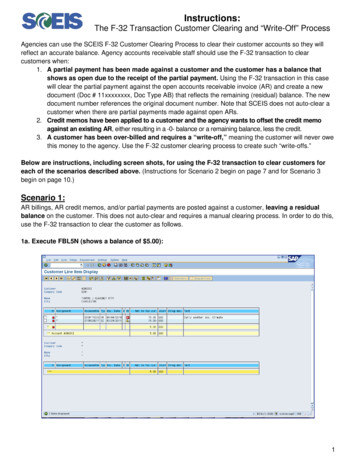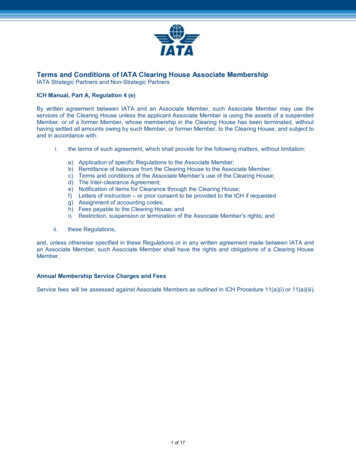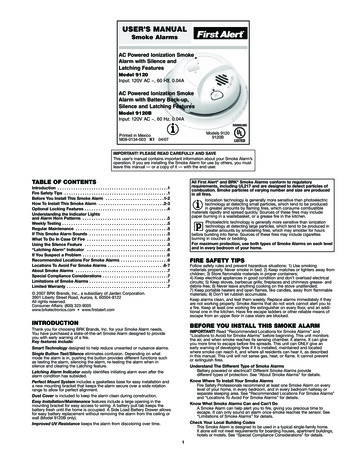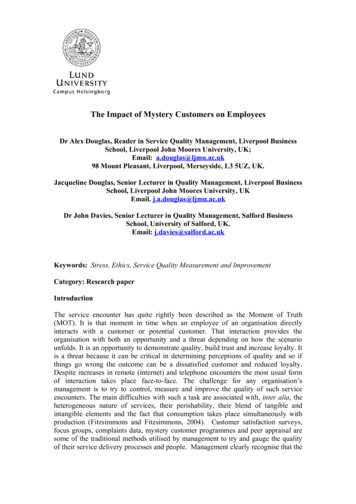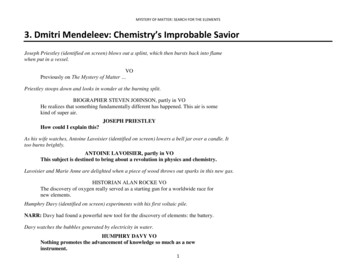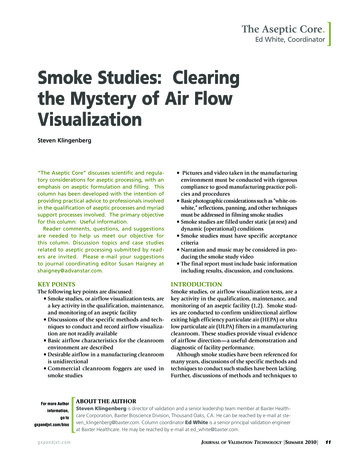
Transcription
The Aseptic Core.Ed White, Coordinator]Smoke Studies: Clearingthe Mystery of Air FlowVisualizationSteven Klingenberg“The Aseptic Core” discusses scientific and regulatory considerations for aseptic processing, with anemphasis on aseptic formulation and filling. Thiscolumn has been developed with the intention ofproviding practical advice to professionals involvedin the qualification of aseptic processes and myriadsupport processes involved. The primary objectivefor this column: Useful information.Reader comments, questions, and suggestionsare needed to help us meet our objective forthis column. Discussion topics and case studiesrelated to aseptic processing submitted by readers are invited. Please e-mail your suggestionsto journal coordinating editor Susan Haigney atshaigney@advanstar.com. Pictures and video taken in the manufacturingenvironment must be conducted with rigorouscompliance to good manufacturing practice policies and procedures Basic photographic considerations such as “white-onwhite,” reflections, panning, and other techniquesmust be addressed in filming smoke studies Smoke studies are filled under static (at rest) anddynamic (operational) conditions Smoke studies must have specific acceptancecriteria Narration and music may be considered in producing the smoke study video The final report must include basic informationincluding results, discussion, and conclusions.KEY POINTSINTRODUCTIONThe following key points are discussed: Smoke studies, or airflow visualization tests, area key activity in the qualification, maintenance,and monitoring of an aseptic facility Discussions of the specific methods and techniques to conduct and record airflow visualization are not readily available Basic airflow characteristics for the cleanroomenvironment are described Desirable airflow in a manufacturing cleanroomis unidirectional Commercial cleanroom foggers are used insmoke studiesSmoke studies, or airflow visualization tests, are akey activity in the qualification, maintenance, andmonitoring of an aseptic facility (1,2). Smoke studies are conducted to confirm unidirectional airflowexiting high efficiency particulate air (HEPA) or ultralow particulate air (ULPA) filters in a manufacturingcleanroom. These studies provide visual evidenceof airflow direction—a useful demonstration anddiagnostic of facility performance.Although smoke studies have been referenced formany years, discussions of the specific methods andtechniques to conduct such studies have been lacking.Further, discussions of methods and techniques toFor more Authorinformation,go togxpandjvt.com/bios[gxpandjv t.comABOUT THE AUTHORSteven Klingenberg is director of validation and a senior leadership team member at Baxter Healthcare Corporation, Baxter Bioscience Division, Thousand Oaks, CA. He can be reached by e-mail at steven klingenberg@baxter.com. Column coordinator Ed White is a senior principal validation engineerat Baxter Healthcare. He may be reached by e-mail at ed white@baxter.com.JournalofValidation T echnology [Summer 2010]11
The Aseptic Core.record airflow visualization are not readily available.The author and staff started performing these testsusing hot plates, water, and dry ice. When the mixturewas in the correct proportions, the “smoke” outputwas great. It would provide enough smoke output tofilm a scene using a video recorder for a few minutes.Of course, while filming the scene, and after gettingthe proper techniques prepared, the smoke wouldfizzle out to nothing at the most critical moment.The end result was a video produced with frustrationand with the bare requirements being met. The staff ’smethods and techniques improved with experience.The training and understanding of the science associated with smoke studies is critically important. Thefinal production of the report and subsequent videowas a culmination of fluid dynamics, photography,manufacturing in a clean room environment, andcreativity. Photographic techniques involving lighting, background impacts, photo angles, and othertechniques are vital to produce a good video.This discussion addresses theoretical backgroundinformation on smoke studies as well as practicalsuggestions for producing video documentation.Unidirectional And Turbulent AirflowBACKGROUNDEQUIPMENT AND SUPPORTSo why produce a smoke study and what does it tell us?Smoke studies tell you about the air flow characteristicsin your International Organization for Standardization (ISO) Class 5 environment. Specifically, if youhave a particle or an airborne contaminant entrainedin the air within your clean room, the smoke test willdemonstrate where the particle will likely move. It isdesired that the particle will be driven in one direction(unidirectional airflow) past the product path andtoward the floor, and then to the room air returns.Studies are typically performed with new installationsor when there are changes to existing systems. Thereshould also be periodic verification that there are nochanges in a given timeframe (e.g., every two years).There are minimal equipment and support requirements for performing a smoke study. The cleanroomfogger (Figure 1) that generates a fog or smoke fromwater vapor using water for injection (WFI) or deionized water is recommended. Methods for generatingthe water vapor fog include megasonic vaporization,steam (liquid nitrogen), and dry ice. These units arecommercially available. Be careful when selectinga cleanroom fogger. There are other methods ofproducing smoke, but many of these methods arenot suitable for a cleanroom installation. Someof these methods, such as glycol or glycerin-basedsmoke, are known to leave residue or activate firealarms (2). A video camera, trained manufacturingpersonnel, and trained smoke study personnel arealso required for conducting these studies. Training is essential for these studies. Strict adherenceto procedures is mandatory.Desired Airflow Characteristics Within AClass 5 EnvironmentThe following are desired airflow characteristics witha Class 5 cleanroom environment: Air flow moves toward potential sources of contamination and away from the product path. Asan example, HEPA (High Efficiency ParticulateAir) filtered air should not flow over clean roompersonnel and then over the product path. Air should be flowing smoothly in one directionwith no turbulence or eddies.12JournalofValidation T echnology [Summer 2010] For movement within the air stream, such as aperson manipulating materials or product, airdisruption should recover quickly (within seconds) to regain unidirectional flow. When doors are opened within Class 5 areas,air flow is disturbed and becomes turbulent asit sweeps through the air stream when opening.Smoke studies should capture the effects of thedisturbance and document the air recovery tosmooth unidirectional air flow.There are two types of airflow characteristics in theindustry: unidirectional airflow and turbulent airflow. Unidirectional smoke studies are designed todemonstrate HEPA filtered air moving in one, smoothdirection known as “unidirectional.” These systemscan be horizontal airflow or vertical airflow. As anexample, in the case of a clean room application, airwill typically enter the room vertically through ceiling-mounted HEPA filters at an expected velocity rate,flow through the defined work zone or space, thenthrough the exit plane of the work area.SMOKE STUDY TECHNIQUE ANDMANUFACTURING PROCEDURESPictures and video taken in the manufacturing environment have inherent risks. Even though the intentof the video may be the smoke study and illustrationof airflow, all other aspects of the aseptic area areillustrated. For example, aseptic techniques of manuiv thome.com
Ed White, Coordinator.FILMING THE SMOKE STUDYPhotography is an art all its own. Unless this is ahobby for those involved or if there is a natural artfulinclination for persons responsible for filming, it canbe very tricky to record in a cleanroom environment.The following are comments on topics associated withphotography and filming the smoke study.White On WhiteEverything in a typical cleanroom tends to be white, suchas gowning and walls. The smoke generated is often lostand becomes invisible to the camera because it is whiteand introduced against the white walls in the background(i.e., white on white). To overcome the issue, it is appropriate to hang a dark material in the background suchas black plastic sheeting taped to the wall. This way thesmoke can clearly be seen and the plastic can easily beremoved and moved to other areas of filming until thesmoke studies are completed (see Figure 1).ReflectionsFilming smoke in the air stream from the ceiling movingdownward to stainless surfaces can also be challenging.In highly-reflective stainless areas, the surfaces can havegxpandjv t.comFigure 1: Smoke generator that utilizes WFI asthe source. Note the black plastic sheeting thatis temporarily hung in the background to aidin filming white smoke against white walls.Source: Smoke study video.Baxter Healthcare Corporation.facturing operators, gowning, equipment setup, andall other associated activities may be scrutinized forcompliance to procedures and industry expectations.Sometimes, the better the smoke studies are, the moreattention the viewer (auditors) pays to techniques thatare apart from the smoke study. They start looking atthe implements used, the movement, proper gowning,operational speed, etc. The smoke studies can lead theinvestigator to raise other questions about your processfrom viewing the video, so it is important to be mindful of using proper technique, tools, and to follow yourprocedures for the process being filmed. As an example,when an operator breaches the barrier to remove a tippedvial, sterile sleeves should be worn by the operator. Thesterile sleeves should cover the arms from the elbow tothe wrist. If in the filming sterile sleeves are not coveringthe areas appropriately, the investigator can change theirattention away from your airflow program to focus onquestions with gowning practices, standard operatingprocedure review, etc.The point here is while sterile sleeves may be inappropriately worn on the arm but have little if any impact onair flow, their improper use can implicate other aspects ofmanufacturing. It is vital to follow your well-establishedgood manufacturing practice (GMP) procedures andprocesses during airflow visualization studies.mirror-like properties. Smoke can look like it is movingdownward, hitting the surface, and then changing direction and moving upward. This is due to the reflections ofthe shiny surfaces of the stainless steel. To overcome this,the photographer should be aware of this phenomenon,and even film from a couple of different angles in orderto present the actual airflow.Starting At The TopBe sure to capture the area where the HEPA-filtered airis introduced, commonly at the ceiling, and slowly pandown following the smoke direction as it flows towardwork surfaces and equipment. The smoke should beintroduced with the nozzle pointed into the airstream.This will demonstrate that the room air supply is sufficient to carry the smoke in the direction of the airflow.Use the zoom function of the camera to capture thearea around the product path and pay particular attentionto open product. Take your time in filming and cameramovement. The use of a tripod can help, but often timesthe areas being filmed are restrictive and without a lotof room to allow for tripod equipment. Be sure to holdthe camera very steady. When panning the camera, moveslowly and deliberately in one direction.Other Room ActivitiesAirflow studies are performed while production areasare “down” (no production activities). Because ofthis, there will often be competition for time in theproduction area for purposes of preventative maintenance, calibration, validation, training, and otheractivities. The team performing smoke studies willhave to coordinate with others in the area to assureJournalofValidation T echnology [Summer 2010]13
The Aseptic Core.Source: Smoke study video.Baxter Healthcare Corporation.Figure 2: Technician performing at-rest studyunder each HEPA filter.that movement within the facility is controlled, thatdoors are kept in their normal condition for manufacturing in order to protect the air pressure cascadesbetween classified areas. The normal airflow patternsshould be protected and maintained by controllingactivities and ingress and egress of personnel.Another consideration while filming is making sureothers don’t walk in front of the camera or disruptthe smoke study production. More typically, I’ve seenpersonnel inadvertently filmed while performingcalibration or preventative maintenance activities bycapturing their activities through windows or doorsin adjacent rooms. The photographer needs to watchfor reflections in glass (windows) and other polishedmaterials. It can be a disruption to the viewer wheninstead of watching the air flow characteristics, theirattentions turn to reflections showing someone ona ladder or doing something on the floor. Again,the discussions during an audit can move away fromthe smoke study itself, and into other areas such asmaintenance access activities, etc.PanoramaAn overview picture scanning the work area can helpto orient the viewer as to where they are in the process. It can also introduce the viewer to the areas offocus and the layout of the room or area. This is veryhelpful to capture before focusing in on a close shotof the process area of interest.It is recommended that map floor plans and roomnumbers be filmed to document exactly where thestudy is taking place.AnglesThe Institute of Environmental Sciences and Technology (IEST) recommends maintaining not more thana 14 angle from vertical. The concern is that with a14JournalofValidation T echnology [Summer 2010]given velocity, a particulate will drop out of air controlif the angle is steeper than 14 . A plumb bob is oftenused if the angles require a reference point or straightline to measure the angle. Refer to IEST-RP-CC006.3for guidance and application.FILMING THE AT-REST STUDY(STATIC CONDITIONS)This portion of the study is intended to capture airflowwithout the effects of personnel or manufacturing. Theareas that will be captured are walkways or corridors,equipment protrusions, and work surfaces that are apotential pathway for the product. Care should betaken to film the simulated smoke where it is introduced, typically 12 to 24 inches from the filter face,and follow the smoke cascade slowly down to the workheight. It may be necessary to move the smoke supplycloser to the work area so that sufficient smoke is generated and can capture the airflow patterns and theireffect as the air flows over and through the equipment.The photographer will follow the product pathway andcapture the smoke flowing over the equipment. It isideal to follow the production sequence.For long walkways, the use of a cart holding thesmoke generator with a mounting bracket holdingthe nozzle in the correct position can help verify eachceiling HEPA filter. Be sure to capture all processingareas including sterile connections, conveyor systems,loading operations, etc. (see Figure 2).FILMING THE OPERATIONAL STUDY(DYNAMIC CONDITIONS)Operational testing is intended to simulate routinemanufacturing activities. Two areas are captured inthis portion of the study. The focus is on the effectsof moving production equipment and componentsand human interventions.Smoke is introduced at the entrance plane, justbelow the HEPA filter usually at the ceiling, and followed downward through the product path. The camera should follow the product, such as a vial movingalong the conveyor system, that moves through thedownward flowing smoke. There should be no turbulence or airflow bouncing off production equipmentor any eddies (air moving in a circular pattern). Smokeshould wash over process equipment and product pathways smoothly in one direction then continue throughthe work area toward the floor. Care should be takento ensure that barrier doors and curtains remain asclosed as possible to maintain the normal air movement conditions as present during manufacturing.iv thome.com
Ed White, Coordinator.ACCEPTANCE CRITERIAThe air supply should continually wash the productexposed area, equipment, and personnel. Airflowshould be unidirectional in nature and should showuniform flow patterns with minimum turbulence. Anyturbulence or “dead spots” should be justified with environmental monitoring studies or other justifications.OPTIONSNarration and music are two options that may beconsidered in support of the smoke study video.NarrationNarration adds an element of professionalism to thevideo. A sound track with the video production ofyour smoke study helps to describe what the vieweris seeing. It’s a way of answering questions beforethey are asked. Some of the elements to be describedin the video should include the study number, thedate, process, the room name and number, a pictureof floor plans or other diagrams that may be helpfulto describe the location, what part of the process isgxpandjv t.comFigure 3: An operator intervention usingproper implements and techniques demonstrated during operation study.Source: Smoke study video.Baxter Healthcare Corporation.Simulations include the use of appropriate gowning, appropriate implements, proper techniques,and following established procedures. Movementis important because we are capturing the airflowpatterns where an operator breeches the barrier andperforms simulations such as removing a tipped vial,making a hose connection, and other pre-describedinterventions. It may be necessary to capture thescenes from a couple of different angles to fullycapture the affects of airflow to dynamic conditionsor to help when working in tight or constrictiveareas and barriers.The photographer should take care to film thesequence carefully to avoid sudden movement of thecamera. It is best to slowly move the camera view inone direction following the product pathway. This willhelp the viewer follow the product path in order ofprocessing. Use caution when zooming in and out ofthe scene or quick camera movements that can causeconfusion or a dizzy collection of scenes. Rememberthe camera will ultimately be the eye of the viewer.Doors that are accessed as part of manufacturingare also tested to demonstrate air recovery patternsafter they have been opened or closed. The air patternrecovery should be within a few seconds. Doors thatare not used during manufacturing, such as maintenance access doors or emergency exit doors, would beexempt from visualization studies (see Figure 3).being filmed, any anomalies that may need furtherexplanation, and the description of the location whereyou are in the area being filmed. Each time a smokestudy is viewed, note any questions or discussionsand be sure to include those items in future smokestudy presentations. Again, the goal of the video andassociated narration is to have a complete description,so ultimately the viewer never has to ask questions orget clarification of what they are seeing.The narration should be recorded separately in aquiet controlled room within a close timeframe offilming the video. It can be too disruptive to try to capture the video, perform the study, and use the propertechniques at the same time as narrating the video.The background noise of the HEPA systems may alsobe too loud to hear what is being said in the video.MusicMusic is an option that may add a further level ofprofessionalism to the video. Carefully chosen,appropriate music can add a relaxing atmosphereand provide continuity between scenes. It helps tofill the void between the periods of narration. Wetypically use an instrumental musical loop of “elevatormusic style” that is played in a continuous loop. Itreally has no beginning or end and we use the sameloop throughout the video. It is played quietly in thebackground and we are careful that it does not drownout the important narration.REPORT CONTENTSReports typically contain the following elements: Study number Date Production area name Company nameJournalofValidation T echnology [Summer 2010]15
The Aseptic Core. Results and discussion Conclusions.The results and discussion, and the conclusionssections of the document are the most importantsections of the smoke study final report. The reportmust clearly indicate the results of the work and endwith a concluding statement whether or not the smokestudy demonstrated the intended objective —that thelaminar airflow system is validated.CONCLUSIONConsider the following elements in your airflow visualization program: Predefined study At-rest Operational Predetermined acceptance criteria Production personnel (process experts) Study execution personnel (airflow experts) Smoke generator Camera Video editing equipment Narration Music (optional) Approved final study report.In closing, if you take the time to plan the at-restand operational studies, remember that the camera is representing the viewer’s eye and provide anexplanation (narration) of what the viewer is seeing.Using each opportunity to continually improve yourairflow visualization program, you should producea quality smoke study.REFERENCES1. White, Ed, “The Aseptic Core: Cleanroom Design,Construction, and Validation,” Journal of ValidationTechnology, Volumn 15, No. 4, Autumn 2009.2. Brande, David, “Clean Room Certification and Particulate Testing,” Environmental Monitoring for Cleanroomsand Controlled Environments, Anne Marie Dixon, ed. Informa Healthcare, New York, 2007.GENERAL REFERENCESISO 14644-1, Cleanrooms And Associated Controlled Environments–Part 1: Classification of Air Cleanliness.ISO 14644-2, Cleanrooms And Associated Controlled Environments–Part 2: Specification for Testing and Monitoring16JournalofValidation T echnology [Summer 2010]to Prove Continued Compliance with ISO 14644-1.ISO 14644-3, Cleanrooms And Associated Controlled Environments–Part 3: Test Methods.ISO 14644-4. Cleanrooms And Associated Controlled Environments–Part 4: Design, Construction and Startup.ISO 14644-5. Cleanrooms And Associated Controlled Environments–Part 5: Operations.ISO 14644-6. Cleanrooms And Associated Controlled Environments–Part 6: Vocabulary,IEST-RP-CC002.3, Unidirectional-Flow, Clean-Air Devices.IEST-RP-CC006.3, Testing Cleanrooms. JVTDEFINITIONSAt-rest (static): Condition where the effects of airflow patterns are moving as designed in a smooth,unidirectional flow, washing over equipment, without manufacturing process or production personnel.Classification: See ISO 14644-1 Cleanrooms and Associated Controlled Environments–Part 1: Classificationof Air Cleanliness, 1999 for classifications.Cleanroom: A room in which the air supply, air distribution, filtration of air supply, materials of construction, and operating procedures are regulated tocontrol airborne particle concentrations to meet appropriate cleanliness levels as defined by ISO 14644.Cleanroom fogger: Generates a “fog” or “smoke”from water vapor using WFI or deionized water.Dynamic (operational): Condition where the installation is functioning in the specified manner, with thespecified number of personnel present and workingin the manner agreed upon.Entrance plane: Perpendicular to the unidirectionalairflow located immediately upstream of the workzone and having the same dimensions as the crosssection of the clean zone perpendicular to the direction of the airflow.Laminar: Federal Standard 209E made the transitionfrom using “laminar flow” to “unidirectional airflow.” Note: Term no longer used except informallyby those who previously used the term regularly.Laminar airflow module: A unit on a bench, ceiling,wall, or work station that incorporates both HEPAfiltered air and unidirectional airflow for the purposeof providing clean air to the work zone.iv thome.com
Ed White, Coordinator.Turbulent airflow: A cleanroom in which the filteredair enters the room in a non-uniform velocity or turbulent flow. Such rooms exhibit non-uniform or random airflow patterns throughout the enclosure.ARTICLE ACRONYM LISTINGUnidirectional: Air that flows in a single pass, in asingle direction, through an air device or clean zone,with generally parallel streamlines.ISOGMPHEPAIESTULPAWFIGood Manufacturing PracticeHigh Efficiency Particulate AirInstitute of Environmental Sciencesand TechnologyInternational Organizationfor StandardizationUltra Low Particulate AirWater-for-InjectionVelocity: Part of the HEPA certification program. Avelocity from 90 to 100 fpm /- 20% (as a guidelinevalue—higher or lower velocities may be more appropriate depending on the specific process) is generallyestablished with a range used since the 1960s whenit was mentioned in the “Non-Mandatory Appendix”of Federal Standard 209A, based on a calculation thata 5μm particle would stay airborne (settle less than2 feet) over a distance of 20 feet in a horizontal flowclean room.Work zone: The volume within the cleanroom thatis designated for contamination-controlled operations, typically defined with an entrance plane andan exit plane.gxpandjv t.comJournalofValidation T echnology [Summer 2010]17
the Mystery of Air Flow Visualization “The Aseptic Core” discusses scientific and regula-tory considerations for aseptic processing, with an . many years, discussions of the specific methods and techniques to conduct such studies have been lacking. Further, discussions of




